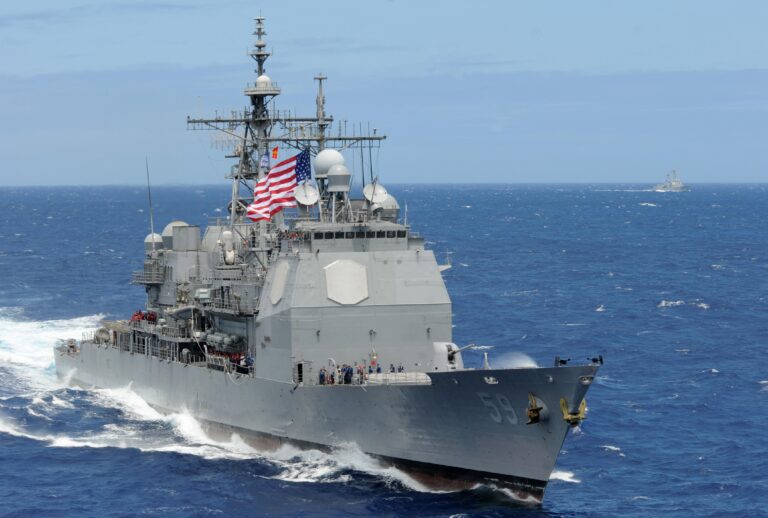The USS Princeton (CG-59) has returned to its homeport in San Diego after completing a nine-month deployment. The guided-missile cruiser, part of the U.S. Navy’s Pacific Fleet, arrived amid a warm welcome from family, friends, and naval personnel. Throughout its deployment, the USS Princeton conducted a range of operations supporting regional security and strengthening alliances in the Indo-Pacific. This homecoming marks a significant milestone as the ship and its crew conclude an extended mission in challenging conditions.
USS Princeton Completes Successful Nine Month Deployment with Strategic Operations
After an extensive nine-month deployment, the USS Princeton has successfully concluded its mission, returning safely to its homeport in San Diego. Throughout this period, the vessel executed a series of critical strategic operations designed to strengthen maritime security and enhance alliance partnerships across various international waters. The deployment included a combination of intelligence gathering, joint training exercises, and rapid response readiness drills, contributing to regional stability and the projection of U.S. naval power.
Key highlights of the mission included:
- Participation in multinational naval exercises focusing on cyber defense and anti-submarine warfare
- Sustained maritime interdiction operations targeting illicit trafficking
- Support for humanitarian assistance and disaster relief efforts in the Indo-Pacific region
Below is an operational summary of the USS Princeton’s deployment achievements:
| Operation Type | Duration | Outcome |
|---|---|---|
| Joint Training Exercises | 3 months | Enhanced interoperability with allied navies |
| Maritime Security Patrols | 4 months | Disrupted several illegal trafficking operations |
| Humanitarian Assistance | 2 months | Provided critical support during regional emergencies |
Insights into USS Princeton’s Role in Enhancing Pacific Security and Allied Cooperation
The USS Princeton (CG-59) played a pivotal role in strengthening regional stability during its recent deployment in the Indo-Pacific theater. Serving as a key component of the U.S. Navy’s forward presence, the ship conducted a variety of operations designed to deter aggression and foster security cooperation with allied maritime forces. Through joint exercises, tactical maneuvers, and real-time intelligence sharing, Princeton enhanced interoperability with partner nations while projecting maritime power in strategic waterways critical to global trade and security.
Highlighted operations included combined drills with navies from Japan, Australia, and the Philippines, which sharpened mutual capabilities and demonstrated united resolve. The ship’s advanced Aegis Combat System provided a robust defensive shield, enabling effective air and missile defense coverage across the region. The multifaceted mission not only reinforced alliances but also contributed to a safer, more stable maritime environment amid evolving geopolitical challenges.
- Allied navies engaged: Japan, Australia, Philippines
- Key systems deployed: Aegis Combat System
- Primary mission focus: Air & missile defense, maritime security
| Operation Aspect | Details |
|---|---|
| Deployment Duration | 9 months |
| Regions Covered | Western Pacific, South China Sea |
| Allied Exercises | 3 major joint drills |
| Capability Highlight | Ballistic missile defense |
Challenges Faced During Deployment and How Crew Overcame Them
During the extended nine-month deployment, the USS Princeton and her crew encountered a range of operational and environmental challenges that tested their resilience and teamwork. One significant obstacle was navigating through harsh weather conditions, including turbulent seas and tropical storms, which demanded precise coordination among the bridge and deck crew to maintain the ship’s course and safety. Additionally, the complexity of coordinating multi-national exercises presented logistical hurdles, especially in communication synchronization and tactical interoperability.
To effectively tackle these issues, the crew implemented a combination of rigorous training drills and adaptive problem-solving strategies. Key measures included:
- Enhanced communication protocols: Conducted continuous system checks and cross-departmental briefings to mitigate misunderstandings during joint operations.
- Real-time weather monitoring: Used advanced meteorological data to anticipate weather changes and adjust navigation plans proactively.
- Stress management initiatives: Implemented team-building activities and allocated downtime to maintain high morale during prolonged periods at sea.
| Challenge | Strategy | Outcome |
|---|---|---|
| Severe weather conditions | Proactive route adjustments & safety drills | Minimal disruptions, safe navigation |
| Communication with allied forces | Regular coordination meetings & technical upgrades | Improved operational efficiency |
| Crew fatigue | Scheduled rest periods & morale programs | Sustained high performance |
Recommendations for Naval Fleet Readiness Based on USS Princeton’s Deployment Experience
Drawing from the extensive operational experiences of USS Princeton during its recent 9-month deployment, it is paramount for naval leadership to prioritize adaptive training programs that simulate real-world combat challenges. Emphasizing flexibility in crew roles and cross-training could significantly enhance response times and operational cohesion during unexpected mission scenarios. Furthermore, maintaining rigorous maintenance schedules, even in forward-deployed environments, ensures high availability rates for critical systems and minimizes downtime.
Key recommendations include:
- Implementing dynamic battle drills tailored to diverse maritime threat environments
- Enhancing cybersecurity protocols given increased reliance on networked systems
- Investing in advanced logistics support for sustained oversea operations
- Increasing joint training exercises with allied forces to boost interoperability
| Readiness Factor | Impact Level | Recommended Action |
|---|---|---|
| Crew Versatility | High | Cross-training sailors across key roles |
| Equipment Maintenance | Critical | Scheduled preventive maintenance cycles |
| Information Security | High | Regular cyber vulnerability assessments |
| Allied Coordination | Medium | Joint operational drills quarterly |
Concluding Remarks
The USS Princeton‚Äôs return to San Diego marks the conclusion of a successful nine-month deployment, underscoring the vessel’s continued commitment to maintaining maritime security and readiness. As the crew reunites with their families and prepares for future missions, the Navy reaffirms its dedication to safeguarding national interests and strengthening alliances across the globe. Further updates on the ship’s upcoming activities will be provided as they become available.





